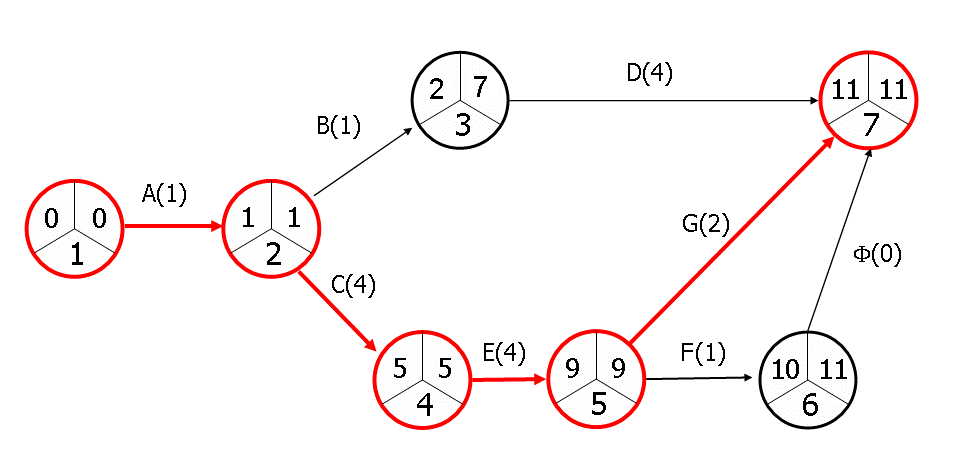Advanced network planning
Programmes describe the sequence in which tasks must be carried out so that a project (or part of a project) can be completed on time.
Programmes will often identify:
- Dates and durations allocated to tasks.
- A critical path (the sequence of critical tasks upon which the overall duration of the programme is dependent).
- Tasks which can only be carried out after other tasks have been completed.
- Tasks which can be carried out simultaneously.
- 'Float' within tasks that are not on the critical path (that is, delays that can be incurred without affecting the critical path).
- The need for specific resources such as plant, services or materials and their lead time.
Developing a programme for a project can be very complex, as there are a great number of interrelated activities to consider, a change in any one of which may impact on all the others.
Advanced network planning is a process that can be used for planning, scheduling and controlling projects (or programmes – that is portfolios of projects) that consist of a large number of interrelated activities.
Network planning techniques first developed in the 1950s and included techniques such as:
- The Critical Path Method (CPM).
- The Program Evaluation and Review Technique (PERT).
- The Precedence Diagramming Method (PDM).
- The Graphical Evaluation and Review Technique (GERT).
- Systematic Network Planning (SNP).
Very broadly, these describe projects as a network of tasks, the interrelationships between which can be used to establish the most appropriate moment for their execution in order to complete the overall project on time.
Creating a network includes a number of steps:
- All the project activities are identified and defined.
- The technological sequence between activities is defined.
- A network is constructed which shows the relative priority of those relationships.
- The execution periods for each activity are estimated.
- The critical path is calculated.
- As time goes on and more information is acquired, the network is revised and re-evaluated.
A typical network will include a set of “arrow diagrams” which go from the origin node to the destination node. In this sense, the path is defined as a sequence of connected activities, which flow from the start of the project (node 1) to the end. The time required to follow one of these paths is the sum of the times corresponding to each of the activities. The critical path is that which requires the longest time to progress from inception to completion, and indicates the minimum timeframe required to complete the whole project.
Complex models can be developed that include additional information such as cost information, and may represent:
- Variables: Aspects in the model that can be changed, such as product type.
- Sensitivities: How much performance changes in response to variable changes.
- Scenarios: The range of possible changes to the network.
Advanced network planning can also be used in applications, such as health and safety management, IT asset sourcing, resource allocation, operations and maintenance scheduling and so on.
This is a complex specialist process that is simplified by the use of software that carries out analysis automatically and outputs results in ways that are easier for the project team to digest, such as gantt charts.
On large projects, the client may appoint a programme consultant who specialises in this subject, and suppliers may have their own programmers.
[edit] Related articles on Designing Buildings Wiki
Featured articles and news
Government consultations for the summer of 2025
A year of Labour, past and present consultations on the environment, the built environment, training and tax.
CMA competitiveness probe of major housing developers
100 million affordable housing contributions committed with further consultation published.
Homes England supports Greencore Homes
42 new build affordable sustainable homes in Oxfordshire.
Zero carbon social housing: unlocking brownfield potential
Seven ZEDpod strategies for brownfield housing success.
CIOB report; a blueprint for SDGs and the built environment
Pairing the Sustainable Development Goals with projects.
Types, tests, standards and fires relating to external cladding
Brief descriptions with an extensive list of fires for review.
Latest Build UK Building Safety Regime explainer published
Key elements in one short, now updated document.
UKGBC launch the UK Climate Resilience Roadmap
First guidance of its kind on direct climate impacts for the built environment and how it can adapt.
CLC Health, Safety and Wellbeing Strategy 2025
Launched by the Minister for Industry to look at fatalities on site, improving mental health and other issues.
One of the most impressive Victorian architects. Book review.
Common Assessment Standard now with building safety
New CAS update now includes mandatory building safety questions.
RTPI leader to become new CIOB Chief Executive Officer
Dr Victoria Hills MRTPI, FICE to take over after Caroline Gumble’s departure.
Social and affordable housing, a long term plan for delivery
The “Delivering a Decade of Renewal for Social and Affordable Housing” strategy sets out future path.
A change to adoptive architecture
Effects of global weather warming on architectural detailing, material choice and human interaction.
The proposed publicly owned and backed subsidiary of Homes England, to facilitate new homes.
How big is the problem and what can we do to mitigate the effects?
Overheating guidance and tools for building designers
A number of cool guides to help with the heat.
The UK's Modern Industrial Strategy: A 10 year plan
Previous consultation criticism, current key elements and general support with some persisting reservations.
Building Safety Regulator reforms
New roles, new staff and a new fast track service pave the way for a single construction regulator.

























